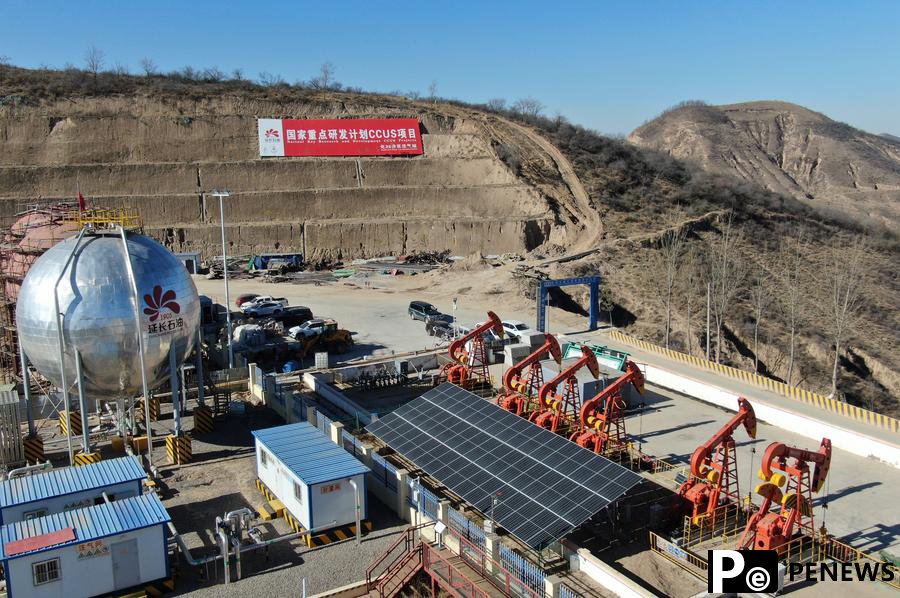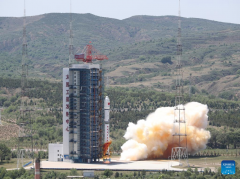Home>>
China's energy-rich provinces embark on green, modern development path(Xinhua) 09:03, April 07, 2024
*China's energy-rich provinces are experiencing a profound transformation in their industrial structure and energy mix as they strive for high-quality growth.
*Energy technology and related industries have become new growth drivers that propel industrial upgrading and promote the development of new quality productive forces.
*In 2023, China's installed renewable energy capacity surpassed its thermal power capacity for the first time in history and China accounted for over half of newly installed renewable energy capacity worldwide.
XI'AN, April 6 (Xinhua) -- Riding on a trackless rubber-tire vehicle, Du Huailong descended into a broad, brightly lit tunnel leading to the coalface of the Daliuta Coal Mine, operated by the Shendong Coal Group Co., Ltd. in northwest China's Shaanxi Province.
Reflecting on his 11 years in the industry, Du recalls the days when miners, with a helmet-mounted lamp and a shovel in hand, would make their way to the deep mineshaft on foot or a rickety small train.
This anecdote represents just one of many significant changes that have swept the mining industry in China over the years. Thanks to intelligent technology such as automated conveyor belts or coal-cutting machines, a single shift comprising just 13 workers can now extract 13,000 tonnes of coal, with per capita efficiency nearly doubling that of a decade ago, according to Du, a mining team leader.
Moreover, workers can remotely control the coal-cutting process at the click of a mouse. "The coal mining industry is no longer characterized solely by physical labor," noted Du.

A worker shows a mobile phone screen that displays real-time data collected from coalface area of the Daliuta Coal Mine operated by the Shendong Coal Group Co., Ltd. in northwest China's Shaanxi Province, Nov. 30, 2023. (Xinhua/Li Yibo)
China's energy-rich provinces are experiencing a profound transformation in their industrial structure and energy mix as they strive for high-quality growth. According to this year's government work report, in 2023, China's installed renewable energy capacity surpassed its thermal power capacity for the first time in history and China accounted for over half of newly installed renewable energy capacity worldwide.
At the same time, energy technology and related industries have become new growth drivers that propel industrial upgrading and promote the development of new quality productive forces.
TECH-EMPOWERED GREEN TRANSITION
Situated at the heart of the primary coal-producing regions of Inner Mongolia, Shanxi, and Shaanxi, Yulin City boasts a proven reserve of 152.7 billion tonnes of coal, along with abundant oil and natural gas resources.
However, despite its rich natural endowment, the city formerly relied heavily on the coal mining industry, resulting in environmental degradation and a simplistic industrial structure.
In recent years, coal companies in Yulin have made great efforts to transition to safe, intelligent, and environmentally friendly utilization of coal. At the YuLin Chemical Co., Ltd., a subsidiary of the Shaanxi Coal and Chemical Industry Group Co., Ltd., researchers have transformed coal into diverse products ranging from everyday items such as knives and forks to absorbable sutures for medical use.
"By expanding the industrial chain, we transform coal into chemical materials such as coal-based specialty fuels and biodegradable materials. This approach not only reduces carbon dioxide emissions but also adds additional value to our products," explained Zheng Baoxiang, vice president of YuLin Chemical.
To achieve China's dual carbon goals of peaking carbon emissions by 2030 and achieving carbon neutrality by 2060, Chinese energy enterprises widely employ carbon capture, utilization, and storage (CCUS) technology to reduce emissions.
At another Yulin-based coal chemical company owned by the Shaanxi Yanchang Petroleum Group Co., Ltd, captured and liquefied carbon dioxide is transported 150 km to the Xingzichuan oilfield for injection into oil layers approximately 1,300 meters underground.

An aerial drone photo taken on Dec. 1, 2023 shows a demonstration project for carbon capture, utilization, and storage (CCUS) by Shaanxi Yanchang Petroleum (Group) Co., Ltd. in Ansai District of Yan'an, northwest China's Shaanxi Province. (Xinhua/Li Yibo)
"The carbon dioxide generated from the coal chemical process is injected underground in place of water, combining oil recovery with carbon sequestration, achieving both water conservation and carbon reduction," said Mei Yan, a technician at the oilfield.
According to a report released last year by several institutions including Tsinghua University, incomplete statistics show that China has nearly 100 planned or operational CCUS projects, with over half already operational. These projects have a combined carbon dioxide capture capacity of four million tonnes per year, among which two million tonnes can be injected underground.
GREEN ENERGIES POWERING THE FUTURE
Facing a series of challenges including immense demand, China has been accelerating the construction of a renewable energy system to enhance its capability to ensure national energy supply.









